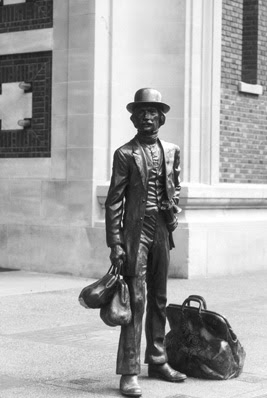
This will be an example of what I mean by Just My Opinion (JMO), often written in shorter form on my
MySpace blog. Hopefully I'll be a little less ranting and more coherent here. Before you decide to rant to me, first understand it's just my opinion, no better or worse and no more right or wrong than yours, it's just different and what each of use are entitled to as Americans under our Constitution. Second, you can read a short
biography to note I'm a Vietnam-era veteran and a now retired 28 year career civil servant. And third, they're observations on what I hear (NPR, etc.), read (5 newspapers, Websites, etc.), and see (observing life).
So, all that aside, what are my views to present in this first post? Well, most come from reading the newspapers of the day and listention to NPR's Morning Edition, All Things Considered, or Weekend Editions. I can't recommend better sources for balanced news and story reporting. And so, I'll get to the first post, which I apologize is lengthy because I haven't posted my views in a few days.
First, the FBI sting to find, arrest and convict terrorist. If there isn't anything harder to believe than our FBI wasting resouces, I don't know about it. As the arrests last years and recent indictments and convictions showed, their sting operations are more recruitment operations. They said they're being "proactive", but where is the line between being proactive to find exising terrorists and literally creating them? The FBI is clearly creating them by having their undercover people create the group, train the group, finance the group, and then arrest them before they actually carry it out? To a civil rights rights lawyer, it's really a WTF moment. They weren't terrorists before, and maybe just inexperienced extremists, so the FBI creates them?
The argument they state is that they were only helping existing ones along in their effors, but records show they actually lead the groups along with providing material, money, information, and in some cases, everything they needed to be a group let alone a terrorist one. Granted, it's fair to say anyone who falls into such a group is either predisposed to terrorism or stupid, or likely both, but don't they have rights here? So who are the terrorists here? The FBI or the suspects? And where is it legal for the FBI to help groups conducting terrorism overseas and not in the US, which is what many of these groups do. Is the FBI the new Interpol now?
Second, the US State Attorneys being fired. News today show the White House was behind some, if not all, of the firings because the Attorneys wouldn't pursue action against Democratic candidates before last year's election. The firings were pure and simple politically motivated actions lead by the White House and done by the US Attorney General. So much for the independence of the Justice Department to support Democracy? I hope Congress thoroughly investigates this and revokes the law they passed giving away oversight and approval to the President.
Third, and probably a very touchy one with many people, but simply put, 9/11 was an event, it is not a reason or an excuse to prohibiting or inhibiting freedoms and rights in the name of anything. It was a horrorific event, but it was one of thousands commited by terrorists in recent history. I am tired of people citing this one event as reason for changing anything. If we do, then they have won, making us live in fear and willing to do anything to appear to be safe, including providing our government with unlimited resources and denying or taking our civil rights.
And it has to be asked, do you feel safer or just being told you're safer (see FBI stings above) because your money is working. For what, our government creating events and media to make it appear they're doing their job? Ok, having said that, my solution? Simple, go back to 9/10 and then make the agencies work together and to the job they're supposed to. It's the adage they're looking for needles in haystacks in a field of haystacks. So, you're looking for something sharp and shiny, not dull and yellow. So why examine every piece of hay? It's called "Focus people!"
How many terrorist have been arrested, indicted and convicted with all the airline and airport safety rules? Try zero. So, why not implement better ways to find terrorists with greater freedoms for citizens to freely travel? We did it before, and some say it failed on 9/11. No! What failed was simple communications, human error in the FAA and FBI. That's all, people failed, the system didn't. So fix the system to make the people better. And five-plus years later the FBI still hasn't fixed the system with hundreds of millions of taxpayers' dollars. For what? They want more money now "to really fix the system."
Enough already. The FBI is failing, so get it right. I'm for that and their work, but never at my personal civil and human rights.
Fourth, Scooter Libby's pardon on the horizon. To Mr. Bush, don't. Let the legal process work. He has deep pocket friends paying the bills, while we pay the prosecution. He clearly lied and mislead people to cover up the real crime which wasn't clearly legal or illegal (it has to do with Valarie Plame's identity and status in the CIA, the disclosure, and the law). But I'm reconcilled George will pardon him the day after the election in 2008 and all our efforts for the truth will be for naught. It will be a sad day in this country, but George knows he's immune to criticism because he simply ignores it.
And lastly, technology and information. It is simply too much to keep up anymore. No wonder most young people tune out or focus on non-important issues. We did the same in our youth, and while the issues were equally important then as now, the enormity of them weren't on the global and international scale. They can't afford to tune out but they can't afford to keep up. And this was the world we created. The point here?
It's simply there is no way to stay abreast of anything, too many people doing too much in anything anymore to know. It's the ever-expanding curve of information, and available in real-time to your cellphone, PDA or similar communications device. It's the nature of the world today, but where does it end? Or is entropy the real and lasting effect? What have we done to create such an environment? Remember it's about the future generations, so in your choice you face decide for them.

It's about the children, their youth to enjoy freedom to be and life free of fear, and it's about their future, what we leave them. Can we do that?




























